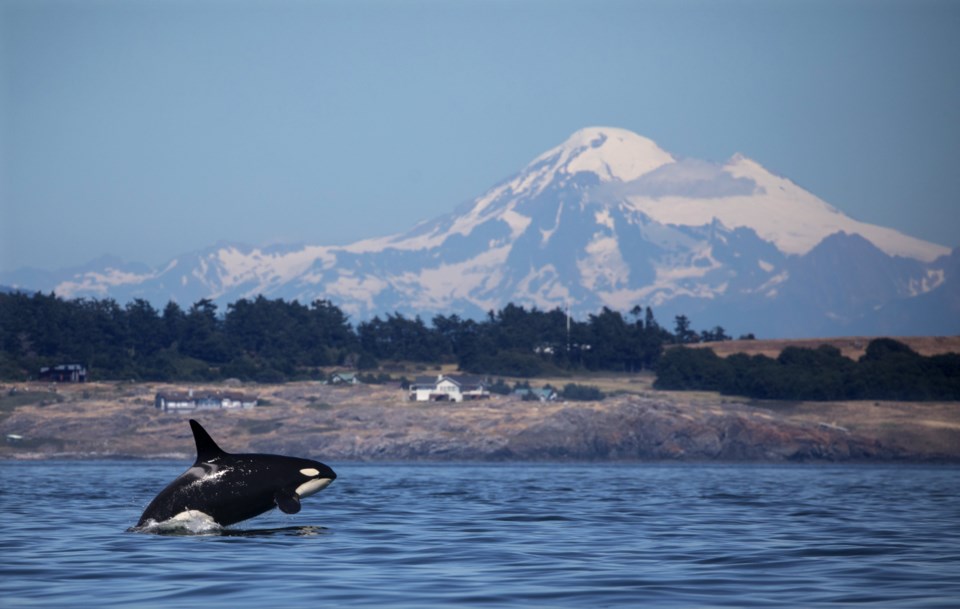For 17 days last summer, a female orca pushed her dead calf through the Pacific Ocean, keeping the body afloat with her head in what some whale experts called a “tour of grief.”
The images of J35, also known as Tahlequah, sparked renewed interest in the plight of endangered southern resident killer whales, whose population had dwindled to just 75 members earlier in the year, following the death of L92 or “Crewser.”
Then, as J35’s vigil continued, public and media attention shifted to an ailing pod member known as J50 or Scarlet.
In the preceding weeks, researchers had become increasingly concerned about the condition of the three-year-old female, whose reproductive potential offered hope for the species’ survival.
As people watched, a team of veterinarians raced to try to save the emaciated whale’s life by using a dart to inject her with medication and attempting to feed her live salmon in hopes of using that method to supply more drugs in the future.
But, after weeks in the spotlight, J50 disappeared one weekend in September and was never seen again.
Her presumed death dropped the number of southern residents to 74 in three pods and added to the sense of urgency around efforts to protect the whales, whose population has fluctuated from 70 to 99 individuals since 1976.
For the Canadian government, those efforts began months earlier with the announcement of a five-year, $167.4-million Whales Initiative in the 2018 budget.
Dominic LeBlanc, fisheries minister at the time, later confirmed that southern residents “face an imminent threat to both survival and recovery.”
He cited a lack of chinook salmon — the whales’ favourite prey — as one of the main problems and announced plans to reduce the annual catch by 25 to 35 per cent.
Federal officials announced fishing closures in parts of the southern Gulf Islands, portions of Juan de Fuca Strait west of Otter Point and around the mouth of the Fraser River.
The closures were welcomed by conservation groups, but panned by the sports fishery for focusing solely on the availability of prey.
Federal officials, however, soon took aim at additional threats to the whales — pollution, which damages their health, and boat noise, which interferes with their ability to forage for food.
Among other things, the government:
• secured a voluntary vessel slowdown in Haro Strait to reduce noise from passing ships;
• introduced a new requirement that whale-watching boats and other vessels stay 200 metres away from the orcas in Canadian waters — twice the previous distance;
• expanded the network of underwater listening devices to measure noise impacts;
• increased aerial patrols to monitor and enforce the new measures;
• boosted the number of fishery officers on the water to enforce closures and crack down on people and boats harassing the whales;
• worked with B.C. Ferries on a plan to manage vessel noise.
In November, LeBlanc’s replacement in the fisheries ministry, Jonathan Wilkinson, pumped an extra $61.5 million into the plan.
The money will be used for to expand the boat slow-down areas, restore chinook habitat, invest in fish hatcheries and tighten controls on flame retardants and other pollutants, he said.
More measures are expected before the expected return of the whales to the Salish Sea in April.
The government has said it’s looking at further fishing reductions and an expansion of fisheries closures in key foraging areas.
Wilkinson said he’ll also be looking closely at Washington Gov. Jay Inslee’s $1.1-billion whale recovery that includes a three-year ban on commercial whale-watching of southern residents.
B.C.’s sports fishing sector, as well as chambers of commerce, are already pushing back at the prospect of more government measures.
The industry says it was badly hurt by fishing closures this summer and fears additional closures in a critical habitat zone that has been expanded to include Swiftsure and La Perouse banks, popular sports fishing areas off southwestern Vancouver Island.
“As British Columbians who are now concerned about the survival of our own businesses and communities, we urge the federal government to slow down the implementation of any additional management measures, take time to get the science right and engage coastal stakeholders,” Karl Ablack, Port Renfrew Chamber of Commerce vice-president, said in a statement.
By contrast, environmental groups want government to accelerate its efforts to save the whales.
In September, Ecojustice lawyers, acting on behalf of five other conservation groups, launched a Federal Court case to press Wilkinson and federal Environment Minister Catherine McKenna to ask cabinet for an emergency order to protect the whales.
The lawsuit was discontinued after it was revealed that the ministers had asked for the emergency order only to be rebuffed by cabinet. But the environmental groups continue to argue that far more needs to be done in light of ongoing threats to the whales and salmon.
They note, for instance, that the Committee on the Status of Endangered Wildlife in Canada recently reported that eight chinook salmon populations are considered “endangered.”
“It all comes back to the footprint that humans are having on the Salish Sea,” said Misty MacDuffee, a biologist with the Raincoast Conservation Foundation. “If we’re going to keep both of these populations around for the future, we have got to change the way that we operate.”
The foundation and other conservation groups want government to ramp up its efforts to protect the whales and chinook by:
• closing marine fisheries that catch chinook from southern B.C.;
• restricting whale-watching of southern residents in critical habitat;
• creating feeding refuges for the whales in which salmon fishing and whale-watching would be prohibited.
“The time is now,” MacDuffee said. “If we have any hope of turning it around, it has to be now.”
— With a file from Carla Wilson



